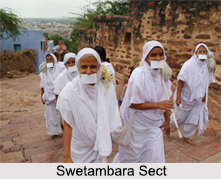 Swetambara Sect is one of the two main sects of Jainism. Jainism is divided into two main sects. They are the Digambaras and the Swetambaras. The word “Swetambara†means white-clad. The ascetics of the Swetambara sect wear white clothes. Swetambaras believe that women can attain Moksha and they also have a belief that Tirthankara Mallinath was a woman.
Swetambara Sect is one of the two main sects of Jainism. Jainism is divided into two main sects. They are the Digambaras and the Swetambaras. The word “Swetambara†means white-clad. The ascetics of the Swetambara sect wear white clothes. Swetambaras believe that women can attain Moksha and they also have a belief that Tirthankara Mallinath was a woman.
Presently within the Swetambara sect there are 2,510 Monks and 10,228 nuns. Some of the Swetambara monks and nuns cover their mouth with a white cloth while talking so that they do not kill any organism in the process. Rather it can be said that they practice Ahimsa in every possible way.
Origin of Swetambara Sect
Swetambaras follow the lineage of Acharya Sthulibhadra Suri. Kalpasutra of Jainism has mentioned some of the ancient lineages of the Swetambaras. History says that Swetambara monastic order traces its origin to "Vrahada Gachchha" which was founded in 937 AD. Some of the prominent classical orders of the ancient days were "Kharatara Gachchha" (1024 AD), "Tapa Gachchha" (1228 AD) and "Tristutik Gachchha".
Sub-Sects of Swetambara
Swetambara sect has also been divided into a number of sub-sects. The major sub-sects of the Swetambara community are;
Murtipujaka
Sthanakvasi
Terapanthi
Murtipujaka Swetambaras: The original form of the Swetambaras was the Murtipujaka Swetambaras. They were the worshippers of idols. They worship the idols with flowers, saffron and ornamented jewels. Their ascetics cover their mouth with strips of cloth while speaking; otherwise they keep them in their hands. They collect food in their bowls from the Sravakas or householders` houses and eat at their place of stay. They mostly dwell in temples or reserved buildings. The Murtipujaka Swetambaras are concentrated in Gujarat.
Sthanakvasi Swetambaras: The Sthanakvasis were not originally part of the Swetambaras but they had arisen as a reform group from the Lonkan sect. As they do not have much difference with the Swetambaras they call them Swetambaras without any hesitation. But a major difference of the Swetambaras and the Sthanakvasis was that the Sthanakvasis did not believe in idol worship. As a result they do not have temples but have prayer halls where they carry out their regular prayers.
Terapanthi Swetambaras: Terapanthis are the last big schism in the Swetambara sect. This Pantha of the Terapanthis are becoming popular. Still now the number of Terapanthis is limited in India and is mostly concentrated in the areas of Jodhpur and Mewar of Rajasthan.




















